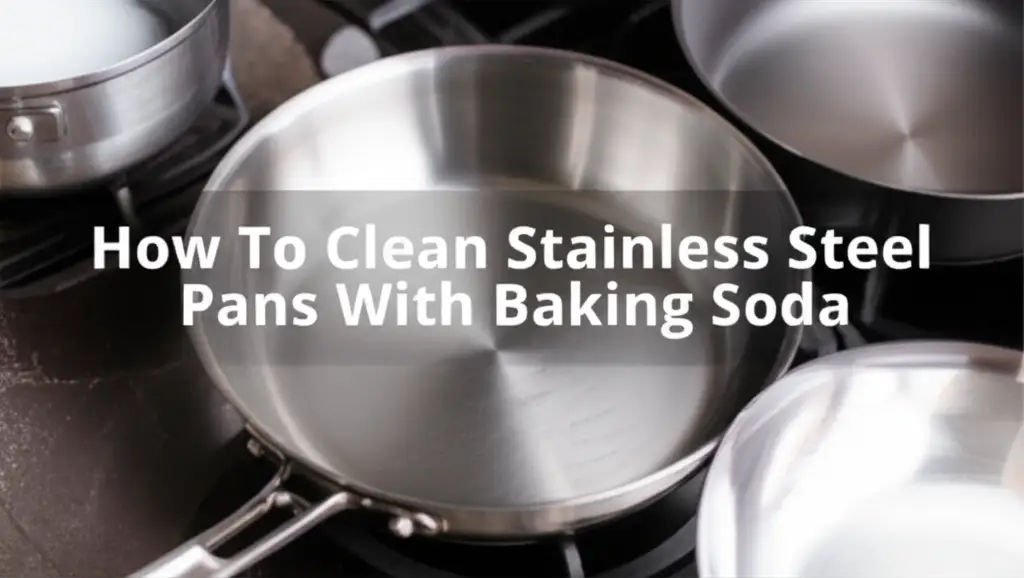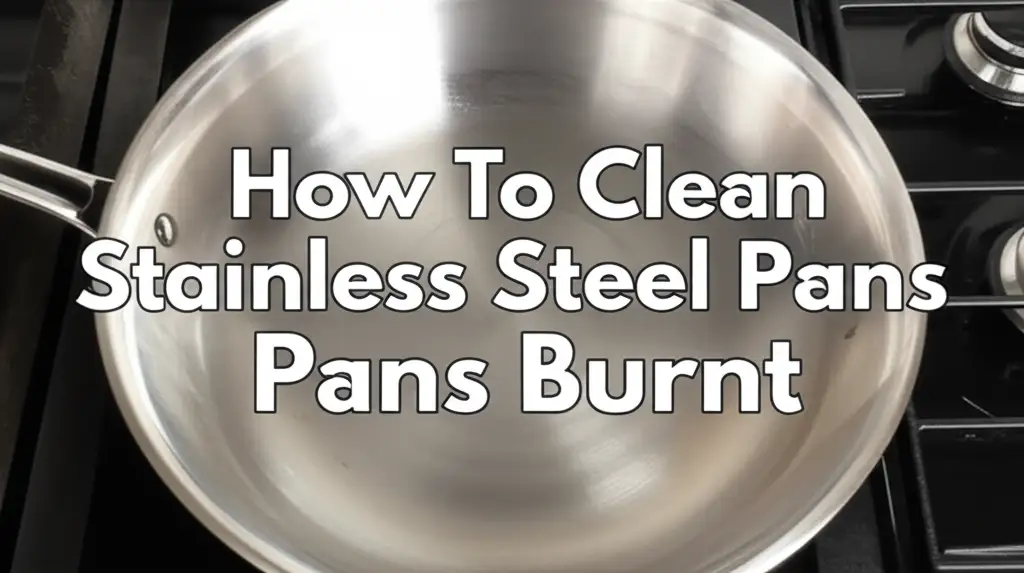· Kitchen Cleaning · 17 min read
How To Clean Stainless Steel Fridge Handles

The Ultimate Guide to Cleaning Stainless Steel Fridge Handles
Key Takeaways
- Use microfiber cloths to avoid scratching stainless steel surfaces
- White vinegar and water solution is an effective natural cleaner
- Always wipe in the direction of the steel grain
- Avoid abrasive cleaners and steel wool that can damage the finish
- Regular maintenance prevents stubborn fingerprints and smudges
Quick Answer: To clean stainless steel fridge handles, wipe with a microfiber cloth dampened with a 50/50 vinegar and water solution, following the direction of the grain. For stubborn spots, apply a paste of baking soda and water, gently scrub, then rinse and dry thoroughly to prevent water spots and streaking.
Why Stainless Steel Fridge Handles Require Special Cleaning Attention
Stainless steel refrigerator handles are among the most frequently touched surfaces in your kitchen. Every time someone reaches for a cold drink or ingredients for dinner, oils and dirt from hands transfer to these surfaces. Despite being called “stainless,” these handles can quickly accumulate fingerprints, smudges, food residue, and even bacteria, detracting from your kitchen’s overall appearance.
The unique properties of stainless steel make it both durable and potentially challenging to clean. Stainless steel has a protective chromium oxide layer that gives it corrosion resistance, but this surface can show every fingerprint and smudge. Additionally, using the wrong cleaning products or techniques can damage this protective layer, leading to permanent streaking or even corrosion over time.
Regular and proper cleaning not only maintains the sleek appearance of your stainless steel fridge handles but also ensures hygiene in an area where food safety is paramount. In this comprehensive guide, we’ll explore effective cleaning methods, recommended products, and maintenance tips to keep your stainless steel fridge handles looking pristine without causing damage.
Whether you’re dealing with everyday smudges or tackling stubborn grime that’s built up over time, the right approach makes all the difference in preserving the beauty and longevity of your stainless steel appliances.
Understanding Stainless Steel Surfaces
Before diving into cleaning methods, it’s important to understand what makes stainless steel unique and why it requires special care. Stainless steel is an alloy containing iron, chromium, and often nickel and other elements. The chromium forms a thin, invisible layer on the surface that protects against rust and corrosion – this is what makes it “stainless.”
The Grain Direction Matters
One of the most important aspects of cleaning stainless steel is understanding the grain direction. If you look closely at your fridge handles, you’ll notice tiny lines running in a specific direction. This is the “grain” of the steel, similar to the grain in wood. Always clean along this grain direction, not against it or in circular motions, to avoid scratching the surface and to achieve the best cleaning results.
Common Challenges with Stainless Steel Handles
Stainless steel fridge handles face specific cleaning challenges:
- Fingerprints and smudges show prominently on the reflective surface
- Oils from hands can build up over time, creating a sticky residue
- Water spots can form if the surface isn’t dried properly
- Hard water minerals can leave deposits, especially in areas with high mineral content
- Some cleaning products can damage the protective chromium oxide layer
- Scratches can occur if abrasive cleaning tools are used
Understanding these challenges helps you choose the right cleaning methods and products to maintain your stainless steel handles without causing damage.
Essential Supplies for Cleaning Stainless Steel Handles
Having the right tools and products on hand makes cleaning stainless steel fridge handles much easier and more effective. Here’s what you’ll need:
Recommended Cleaning Tools
- Microfiber cloths: These are essential for cleaning stainless steel without scratching. Keep several on hand – one for applying cleaning solution, one for rinsing, and one for drying.
- Soft-bristled toothbrush: For reaching crevices around handle attachments
- Spray bottles: For mixing and storing homemade cleaning solutions
- Rubber gloves: To protect your hands from cleaning chemicals
Effective Cleaning Solutions
- Commercial stainless steel cleaners: Products specifically formulated for stainless steel, like Weiman Stainless Steel Cleaner or Method Stainless Steel Cleaner
- White vinegar: A versatile natural cleaner that cuts through grease and disinfects
- Mild dish soap: For basic cleaning without harsh chemicals
- Baking soda: For tackling stubborn stains and grime
- Olive oil or mineral oil: For polishing after cleaning (optional)
- Isopropyl alcohol: For disinfecting and removing stubborn fingerprints
Avoid these products that can damage stainless steel:
- Bleach and chlorine-based cleaners
- Abrasive powders
- Steel wool and abrasive scrubbing pads
- Ammonia-based products
- Oven cleaners
Having these supplies ready will make your cleaning process more efficient and help protect your stainless steel surfaces from damage.
Step-by-Step Daily Cleaning Method
Regular maintenance cleaning is the key to keeping your stainless steel fridge handles looking their best. Follow this simple daily or every-other-day routine to prevent buildup and maintain shine:
Quick Daily Wipe-Down Procedure
Prepare your cloth: Dampen a clean microfiber cloth with warm water and wring out excess moisture. The cloth should be damp, not wet.
Wipe in the direction of the grain: Gently wipe the handle following the direction of the grain. This removes fingerprints, light smudges, and dust.
Dry thoroughly: Use a second, dry microfiber cloth to dry the handle completely. This prevents water spots and streaks.
Optional quick disinfection: For an extra level of cleanliness, especially during cold and flu season, lightly dampen a cloth with rubbing alcohol and wipe the handles, following with a dry cloth.
Best Time to Clean Handles
The best time to perform this quick cleaning is either in the morning after breakfast or in the evening after dinner cleanup. Making it part of your routine ensures consistent cleanliness and prevents buildup that requires deeper cleaning.
Remember that consistency is more important than intensity when it comes to maintaining stainless steel surfaces. A gentle daily wipe is better than occasional aggressive scrubbing, which can damage the finish over time.
Deep Cleaning Methods for Stubborn Grime
Even with regular maintenance, stainless steel fridge handles occasionally need deeper cleaning to remove accumulated grime, sticky residue, or water spots. Here are effective methods for deeper cleaning:
Vinegar and Water Solution
This is one of the most effective natural cleaning methods for stainless steel:
- Mix equal parts white vinegar and water in a spray bottle.
- Spray the solution onto a microfiber cloth (not directly onto the handle to prevent dripping into crevices).
- Wipe the handle in the direction of the grain, applying gentle pressure.
- Rinse with a clean, damp cloth.
- Dry thoroughly with another clean microfiber cloth.
The acidity in vinegar cuts through grease and removes water spots effectively. The slight odor dissipates quickly as it dries.
Baking Soda Method for Stubborn Spots
For tougher grime or sticky spots:
- Create a paste with baking soda and water (about 1:1 ratio).
- Apply the paste to stubborn spots using a soft cloth or soft-bristled toothbrush.
- Gently rub in the direction of the grain.
- Let sit for 5-10 minutes for difficult spots.
- Wipe away the paste with a damp microfiber cloth.
- Rinse thoroughly to remove all baking soda residue.
- Dry completely with a clean cloth.
Dish Soap for Greasy Buildup
For handles with greasy residue:
- Mix a few drops of mild dish soap in warm water.
- Dampen a microfiber cloth with the solution and wring out excess.
- Wipe handles in the direction of the grain.
- Rinse thoroughly with a clean, damp cloth to remove all soap residue.
- Dry immediately and thoroughly.
These deep cleaning methods should be used once a week or as needed when you notice buildup that doesn’t come off with daily wiping.
How to Remove Specific Stains and Residues
Different types of stains and residues require specific approaches. Here’s how to tackle common issues that affect stainless steel fridge handles:
Removing Fingerprints and Smudges
Fingerprints are perhaps the most common issue with stainless steel surfaces:
- For quick removal, use a microfiber cloth with a small amount of rubbing alcohol.
- Wipe in the direction of the grain.
- Follow with a dry cloth to prevent streaking.
Alternatively, specially formulated stainless steel wipes can make this process even quicker for everyday maintenance.
Tackling Calcium and Hard Water Deposits
In areas with hard water, mineral deposits can form on handles:
- Apply undiluted white vinegar to the affected area using a cloth.
- Let it sit for 5-10 minutes to dissolve the mineral deposits.
- Wipe with a damp cloth in the direction of the grain.
- For stubborn calcium deposits, you can create a stronger solution with equal parts white vinegar and lemon juice.
- Rinse thoroughly and dry immediately.
Removing Sticky Residue
For sticky substances like dried juice or food residue:
- Apply a small amount of mineral oil, baby oil, or cooking oil to a cloth.
- Rub the sticky area in the direction of the grain.
- Once the sticky substance loosens, clean with dish soap solution.
- Rinse thoroughly and dry completely.
Addressing Discoloration or Rust Spots
If you notice discoloration or early signs of rust:
- Create a paste of baking soda and water.
- Apply to the discolored area and gently rub with a soft cloth in the direction of the grain.
- For persistent spots, a commercial stainless steel cleaner with oxalic acid may be needed.
- Always rinse thoroughly and dry completely after treating rust spots.
Remember that prevention is easier than treatment – drying handles thoroughly after cleaning is the best way to prevent water spots and potential rust formation.
Natural Cleaning Solutions vs. Commercial Products
When it comes to cleaning stainless steel fridge handles, you have choices between natural cleaning solutions and commercial products. Each has its advantages and specific uses.
Effective Homemade Cleaning Solutions
Natural cleaning methods offer environmental and health benefits while being cost-effective:
Vinegar solution: Equal parts white vinegar and water create an excellent all-purpose cleaner for stainless steel. The acidity cuts through grease and disinfects surfaces.
Baking soda paste: For scrubbing power without scratching, mix baking soda with just enough water to create a paste. This works well on stubborn spots.
Olive oil polish: After cleaning, a tiny amount of olive oil on a soft cloth can be used to polish handles and reduce future fingerprints. Use sparingly and buff thoroughly.
Lemon juice solution: Similar to vinegar, lemon juice works well on water spots and mineral deposits due to its natural acidity.
Recommended Commercial Stainless Steel Cleaners
For convenience or tough cleaning challenges, these commercial products work well:
Weiman Stainless Steel Cleaner & Polish: Creates a protective barrier against fingerprints and smudges
Method Stainless Steel Cleaner: Plant-based formula that’s effective and environmentally friendly
Bar Keepers Friend: Excellent for removing tough stains and discoloration
Therapy Premium Stainless Steel Cleaner & Polish: Contains coconut oil for cleaning and protecting
When choosing between natural and commercial options, consider:
- Frequency of cleaning needed
- Types of stains you typically encounter
- Presence of children or pets who might contact surfaces
- Personal preference regarding chemical use
- Cost considerations over time
Many homeowners find that a combination approach works best – daily maintenance with simple water or vinegar solution, and occasional use of commercial products for deeper cleaning or polishing.
Preventing Damage While Cleaning Stainless Steel
Improper cleaning techniques can damage stainless steel surfaces. Here’s how to protect your fridge handles while cleaning:
Common Mistakes to Avoid
Using abrasive tools: Never use steel wool, metal brushes, or abrasive scrubbing pads on stainless steel. These can scratch the surface permanently.
Cleaning against the grain: Always wipe in the direction of the metal grain to avoid scratches and streaks.
Using chlorine bleach or ammonia: These chemicals can damage the protective chromium oxide layer on stainless steel. Even diluted solutions can cause pitting or corrosion over time.
Letting water air dry: Water spots form when drops are allowed to air dry on stainless steel. Always dry surfaces thoroughly after cleaning.
Using dirty cloths: Reusing dirty cloths can spread grime rather than remove it, and may contain particles that scratch surfaces.
Safe Cleaning Techniques
Test in an inconspicuous area: Before using any new cleaning product, test it in a small, less visible area of the handle to ensure it doesn’t cause discoloration or damage.
Use gentle pressure: Let the cleaning solution do the work rather than applying excessive force when wiping or scrubbing.
Change cloths when needed: Use clean sections of your microfiber cloth or switch to a fresh cloth when the first becomes dirty.
Rinse thoroughly: Any cleaning solution left behind can attract more dirt or cause streaking, so always rinse well.
Dry immediately and thoroughly: Use a clean, soft cloth to dry handles completely after cleaning to prevent water spots and potential corrosion.
By avoiding these common mistakes and following safe cleaning techniques, you’ll maintain the appearance of your stainless steel fridge handles while extending their lifespan.
Maintaining Stainless Steel Fridge Handles Long-Term
Establishing a regular cleaning routine not only keeps your fridge handles looking great day-to-day but also helps preserve them for years to come. Here’s how to maintain stainless steel fridge handles for the long term:
Regular Maintenance Schedule
Create a cleaning schedule that works for your household:
- Daily: Quick wipe with a damp microfiber cloth to remove fingerprints and smudges
- Weekly: Deeper cleaning with vinegar solution or mild soap
- Monthly: Polishing with appropriate stainless steel polish or olive oil to create a protective barrier
- Quarterly: Inspection for any signs of damage, corrosion, or areas needing special attention
Protecting Handles Between Cleanings
Consider these preventive measures to reduce cleaning frequency:
Apply a thin protective coating: After thorough cleaning and drying, apply a very thin layer of mineral oil, baby oil, or commercial stainless steel polish. Buff thoroughly until no residue remains. This creates a barrier that repels fingerprints and water spots.
Consider handle covers: For households with small children, temporary silicone or fabric handle covers can reduce cleaning needs during messy cooking phases.
Install touchless options: If you’re in the market for a new refrigerator, consider models with touchless opening features or handles less prone to showing fingerprints.
Hand washing before use: Encourage family members to wash hands before opening the refrigerator, especially after handling greasy foods.
With consistent care and maintenance, your stainless steel fridge handles will maintain their sleek appearance and hygienic surface for many years, enhancing both the functionality and aesthetics of your kitchen.
Cleaning Different Types of Stainless Steel Finishes
Not all stainless steel surfaces are identical. Different manufacturers use various finishes that might require slightly different cleaning approaches:
Standard Polished Finish
Most common on refrigerators, this highly reflective finish shows fingerprints easily:
- Use microfiber cloths exclusively
- Light oil polishing works well on this finish
- Commercial products specifically for fingerprint resistance are most beneficial here
Brushed or Satin Finish
This finish has a more textured look with visible grain lines:
- Clean strictly in the direction of the grain
- May require more attention in the small grooves where dirt can accumulate
- Generally more forgiving with fingerprints than polished finishes
Fingerprint-Resistant Finishes
Modern appliances often feature fingerprint-resistant coatings:
- Use gentler cleaning methods without harsh chemicals
- Avoid oil-based polishes which can damage the special coating
- Often only require water and a soft cloth for cleaning
- Follow manufacturer’s specific recommendations
Handle Material Variations
Some stainless steel refrigerators have:
- Plastic or rubber inserts in handles
- Textured grip sections
- Coated or painted portions
For these variations:
- Clean the non-stainless portions with appropriate materials
- Avoid letting cleaning solutions for the stainless parts contact plastic components
- Pay special attention to seams and joints where different materials meet
Always check your refrigerator’s manual for specific cleaning recommendations from the manufacturer, especially for newer models with specialized finishes.
Cleaning Stainless Steel Handles for Different Refrigerator Brands
Different refrigerator manufacturers may use slightly different stainless steel formulations or finishes. Here are some brand-specific considerations:
Samsung Stainless Steel Refrigerators
Samsung refrigerators, particularly those with their “fingerprint resistant” finish, require special care:
- Use a soft microfiber cloth with warm water as the first cleaning method
- For their black stainless steel, avoid abrasive cleaners completely
- Their proprietary finishes can be damaged by harsh chemicals, so stick to mild solutions
- For Samsung’s standard stainless steel, a vinegar solution works well for regular cleaning
LG and Whirlpool Models
These brands typically use traditional stainless steel finishes:
- Standard cleaning methods with vinegar solutions or mild soap generally work well
- Their handles often have a clear protective coating from the factory that should be maintained
- For PrintShield™ finishes (Whirlpool), avoid oil-based cleaners
Sub-Zero and High-End Brands
Premium refrigerator brands often use higher-grade stainless steel:
- May be more resistant to corrosion but still susceptible to fingerprints
- Often benefit from specialized stainless steel cleaners
- Typically have more detailed cleaning instructions in their manuals
- May have unique handle designs requiring special attention around seams and attachments
GE Profile and Café Series
These refrigerators often feature specialized handle designs:
- Pay attention to crevices where handles attach to the door
- Some models have customizable handles with different materials
- For handles with brushed finishes, direction of cleaning is particularly important
Always consult your specific refrigerator’s manual for the manufacturer’s recommended cleaning products and methods, as using incorrect cleaners might void warranties on some high-end models.
Frequently Asked Questions About Cleaning Stainless Steel Fridge Handles
What is the best home remedy to clean stainless steel fridge handles?
The most effective home remedy is a 50/50 mixture of white vinegar and water. The acidic properties of vinegar cut through grease and fingerprints while being gentle enough not to damage the stainless steel surface. For polishing after cleaning, a tiny amount of olive oil applied with a soft cloth can create a beautiful shine and protective layer.
How do I remove stubborn fingerprints from my stainless steel refrigerator handles?
For persistent fingerprints, dampen a microfiber cloth with rubbing alcohol and wipe in the direction of the grain. The alcohol cuts through the oils in fingerprints without damaging the surface. Follow with a dry cloth to prevent streaking. For severe cases, a specialized stainless steel cleaner with fingerprint-resistant properties can provide longer-lasting results.
Can I use Windex or glass cleaner on stainless steel fridge handles?
It’s best to avoid ammonia-based products like Windex on stainless steel surfaces. While they might clean temporarily, they can damage the protective chromium oxide layer over time, leading to discoloration or corrosion. Stick to cleaners specifically formulated for stainless steel or natural alternatives like vinegar and water.
How do I prevent water spots on my stainless steel refrigerator handles?
Water spots form when minerals in water are left behind after evaporation. To prevent them, always dry handles thoroughly with a clean, soft cloth immediately after cleaning. For persistent water spots, a solution of equal parts white vinegar and water can dissolve mineral deposits. In hard water areas, consider using distilled water for cleaning stainless steel surfaces.
What cleaning products should I never use on stainless steel?
Never use chlorine bleach, oven cleaners, steel wool, abrasive scrubbing pads, or highly alkaline cleaners (like ammonia) on stainless steel. These can permanently damage the protective layer, cause scratches, or lead to discoloration and corrosion. Also avoid products containing hydrochloric acid, sulfuric acid, or chlorides, which can damage stainless steel even in small amounts.
How often should I polish my stainless steel fridge handles?
Polishing stainless steel handles with an appropriate polish or oil should be done about once a month for optimal results. However, this depends on usage – households with children or heavy kitchen use might benefit from bi-weekly polishing. Regular daily or weekly cleaning doesn’t require polishing each time. Remember that over-polishing or using too much product can lead to buildup that attracts more dirt.
Final Thoughts on Maintaining Beautiful Stainless Steel Handles
Keeping your stainless steel refrigerator handles clean and pristine doesn’t have to be complicated or time-consuming. With regular maintenance and the right techniques, you can maintain that showroom shine for years to come.
Remember that consistency is key – a quick daily wipe to remove fingerprints and smudges prevents the need for more intensive cleaning later. By always cleaning in the direction of the grain, using appropriate non-abrasive tools, and drying thoroughly after cleaning, you’ll prevent the most common issues that affect stainless steel surfaces.
Whether you prefer natural cleaning solutions like vinegar and baking soda or commercial stainless steel products, the most important factors are using the right technique and avoiding damaging chemicals and tools. Your choice of cleaning solution matters less than your consistency and proper method.
Clean, gleaming stainless steel handles contribute significantly to the overall appearance of your kitchen. They’re often the first thing people touch when interacting with your refrigerator, making their maintenance not just about aesthetics but also about hygiene.
For more information on keeping other stainless steel surfaces in your home looking their best, check out our guides on how to clean stainless steel shower fixtures or maintaining stainless steel sinks.
We hope this comprehensive guide helps you maintain spotless, fingerprint-free stainless steel fridge handles with minimal effort and maximum results!
- stainless steel cleaning
- fridge handles
- kitchen cleaning




